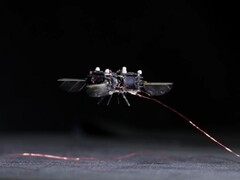A team of researchers at the Massachusetts Institute of Technology (MIT) is developing a bee-like robot that can flap its wings up to 400 times per second. The project — led by principal investigator Kevin Chen at MIT’s Soft and Micro Robotics Lab — aims to mimic the amazing maneuvers that bumblebees are capable of.
The researchers say the robotic bee could someday handle tasks like artificial pollination. This could be useful in environments where real bees cannot survive, such as indoor warehouse farms with ultraviolet lighting. The team also think it holds the potential of doing the same job on other planets.
If you’re going to grow something on Mars, you probably don’t want to bring a lot of natural insects to do the pollination. That’s where our robot could potentially come into play. — Yi-Hsuan Hsiao, a PhD student working on the project.
This tiny robot — which weighs less than a paperclip — flies around using soft muscles that rapidly contract and elongate. The research team is also working on a more energy-efficient robot that combines flying and hopping. This hopping robot — smaller than a human thumb — consumes about 60% less energy than the flying version. Because of the higher energy efficiency, it can carry about 10 times more payload. The team already demonstrated that it can carry a load twice its weight, but its maximum payload may be even higher than tested.
The robots are powered via a wire, as fitting batteries on such tiny robots is a Herculean task. Chen estimates such robots might still be 20–30 years away from development. However, their work might pave the way for the next generation of micro-robots.






























